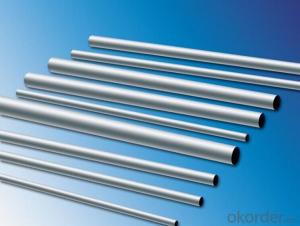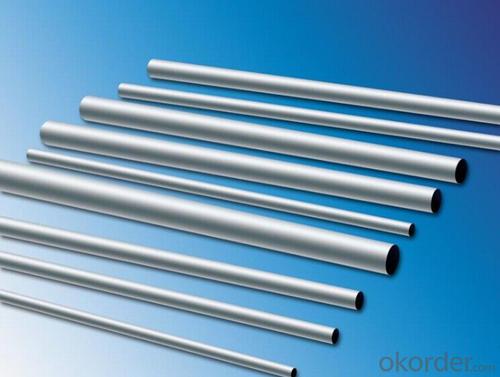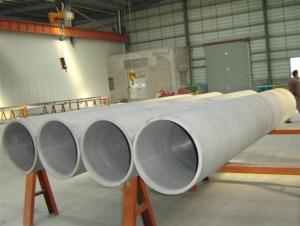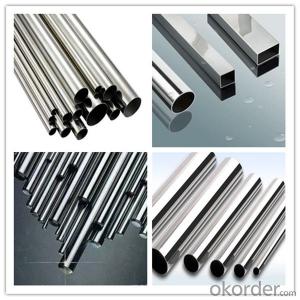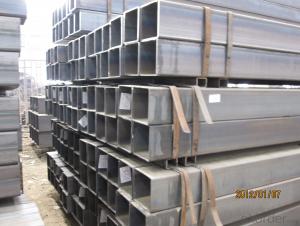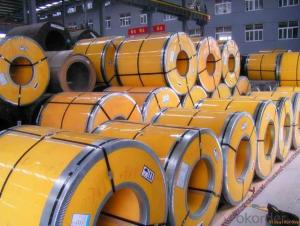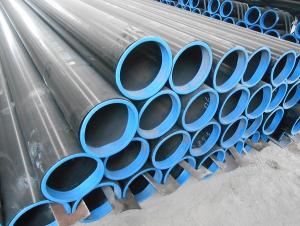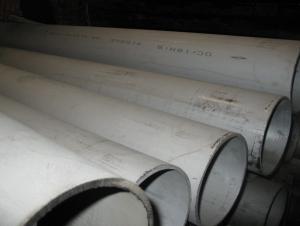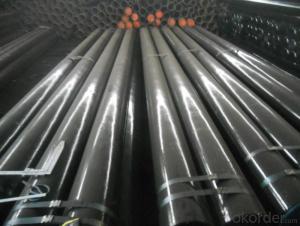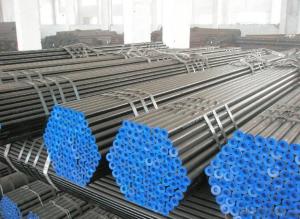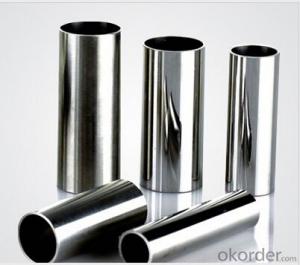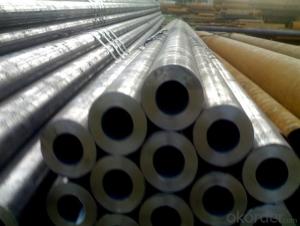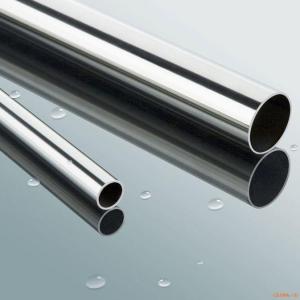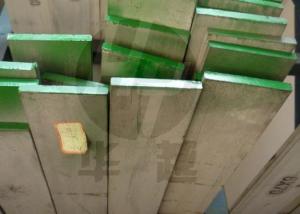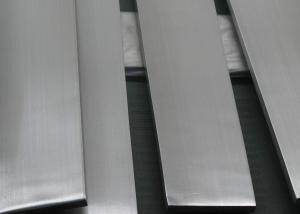Round Section Hot Rolled Stainless Steel Pipe MOQ 30MT
- Loading Port:
- Tianjin
- Payment Terms:
- TT OR LC
- Min Order Qty:
- 30 m.t.
- Supply Capability:
- 3000 m.t./month
OKorder Service Pledge
OKorder Financial Service
You Might Also Like
Specification
Round Section Hot Rolled Stainless Steel Pipe MOQ 30MT
1.Structure of Stainless Steel Pipe :
Stainless steel pipe is formed by drawing a solid billet over a piercing rod to create the hollow shell. As the manufacturing process does not include any welding, seamless pipes are perceived to be stronger and more reliable. Historically seamless pipe was regarded as withstanding pressure better than other types, and was often more easily available than welded pipe.
2.Main Features of the Stainless Steel Pipe :
• High manufacturing accuracy
• High strength
• Small inertia resistance
• Strong heat dissipation ability
• Good visual effect
• Reasonable price
3.Stainless Steel Pipe Specification:
Standard | GB, DIN, ASTM ASTM A106-2006, ASTM A53-2007 |
Grade | 10#-45#, 16Mn 10#, 20#, 45#, 16Mn |
Thickness | 8 - 33 mm |
Section Shape | Round |
Outer Diameter | 133 - 219 mm |
Place of Origin | Shandong, China (Mainland) |
Secondary Or Not | Non-secondary |
Application | Hydraulic Pipe |
Technique | Cold Drawn |
Certification | API |
Surface Treatment | factory state or painted black |
Special Pipe | API Pipe |
Alloy Or Not | Non-alloy |
Length | 5-12M |
Outer Diameter | 21.3-610mm |
Grade | 20#, 45#, Q345, API J55, API K55, API L80, API N80, API P110, A53B |
Standard | ASME, ASTM |
1) Material:20#(ASTM A 106/A53 GRB.API5LGRB,GB),45#,16Mn,10#.
2) Specification range:OD:21.3-610mm,WT:6-70mm,length:6-12m or according to the requirement of clients.
3) Excutive standards:GB,ASME API5L.ASTM A 106/A53,Despite of the above standards,we can also supply seamless steel pipe with standard of DIN,JIS,and so on,and also develop new products according to the requirements of our clients!
4) Surface:black lacquered,varnish coating or galvanized.
5) Ends:Beveled or square cut,plastic capped,painted.
6) Packing:bundles wrapped with strong steel strip,seaworthy packing.
4. Application of Stainless Steel Pipe
Stainless steel pipe is used for structural and piping applications that require the properties that stainless steel delivers – high strength, toughness and excellent corrosion resistance. The pipe is available in sizes 1/2" through 36” in outside diameter (OD) and schedules 05S through 80S and larger for wall thickness (WT). It is available as welded and seamless. Stainless pipe has a dull gray, mill finish.
5.Packaging & Delivery
Packaging Details: | seaworthy package,bundles wrapped with strong steel strip |
Delivery Detail: | 50-60days after received 30%TT or Original LC |
6.FAQ of Stainless Steel Pipe :
A. How is the quality of your products?
Our products are manufactured strictly according to national and internaional standard, and we take a test on every pipe before delivered out. If you want see our quality certifications and all kinds of testing report, please just ask us for it.
Guaranteed: If products’ quality don’t accord to discription as we give or the promise before you place order, we promise 100% refund.
trust the quotation we would give you, it is professional one.
B. Why should you chose us?
Chose happens because of quality, then price, We can give you both.Additionally, we can also offer professional products inquiry, products knowledge train(for agents), smooth goods delivery, exellent customer solution proposals.Our service formula: good quality+good price+good service=customer’s trust
SGS test is available, customer inspection before shipping is welcome, third party inspection is no problem.
Any question, pls feel free to contact us !
7. Seamless Pipe ASTM A106/53 Images:
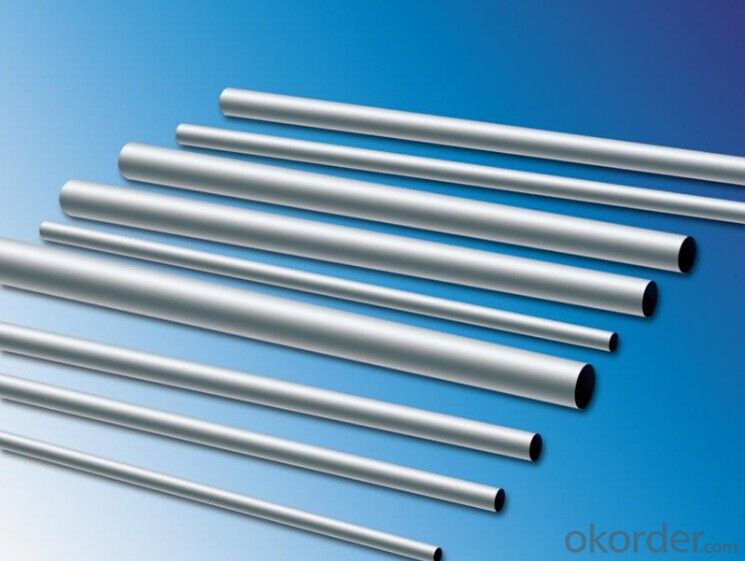
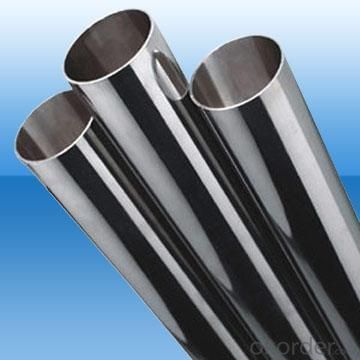
8. Company Information:
CNBM International Corporation (CNBM International) is the most important trading platform of CNBM Group Corporation, a state-owned company under the direct supervision of State-owned Assets Supervision and Administration Commission of the State Council.
In line with the business, CNBM International launched E-business platform Okorder.com.Our goal is to transform CNBM International into the global leading brand in building materials industry within 3 to 5 years through innovation and reform, by strengthening the overall management of supply chain, developing and cultivating both domestic and overseas market, improving the procedure and information system, enhancing the ability to organize resources and to provide value-added services under a professional team and a learning organization.
- Q: What is the difference between annealed and tempered stainless steel pipes?
- Annealed and tempered stainless steel pipes are both heat-treated to enhance their properties, but they differ in terms of their mechanical characteristics and applications. Annealed stainless steel pipes are soft and ductile due to the annealing process, which involves heating the material to a high temperature and then slowly cooling it. This process relieves internal stresses and increases the steel's flexibility, making it easier to bend and form. Annealed pipes have lower hardness and strength but are more resistant to corrosion. On the other hand, tempered stainless steel pipes undergo a different heat treatment process called tempering. After being quenched, the steel is reheated to a specific temperature and then cooled rapidly. This process improves the steel's strength, hardness, and toughness, making it more suitable for applications that require high mechanical properties. Tempered pipes have higher hardness and strength but may be slightly less resistant to corrosion compared to annealed pipes. The choice between annealed and tempered stainless steel pipes depends on the specific application. Annealed pipes are commonly used in industries that require excellent corrosion resistance and flexibility, such as food processing, pharmaceutical, and chemical industries. Tempered pipes, on the other hand, are preferred in applications that require higher strength and durability, such as construction, automotive, and aerospace industries. In summary, annealed stainless steel pipes are softer and more flexible with better corrosion resistance, while tempered stainless steel pipes are stronger and harder with slightly reduced corrosion resistance. The selection of the appropriate type depends on the mechanical requirements and the environment in which the pipes will be used.
- Q: What are the advantages of using stainless steel pipes in the oil and gas industry?
- There are several advantages of using stainless steel pipes in the oil and gas industry. 1. Corrosion resistance: Stainless steel pipes are highly resistant to corrosion, making them ideal for transporting oil and gas. They can withstand extreme temperatures, harsh chemicals, and corrosive environments, ensuring long-term durability and preventing costly repairs or replacements. 2. Strength and durability: Stainless steel pipes have high tensile strength, which means they can withstand heavy loads and high-pressure environments. This characteristic makes them suitable for transporting oil and gas over long distances, as they can handle the required stress without compromising their structural integrity. 3. Hygienic and clean: Stainless steel pipes are non-porous and have a smooth surface, making them resistant to bacterial growth and minimizing the risk of contamination. This is crucial in the oil and gas industry, where maintaining the purity and quality of the transported fluids is paramount. 4. Heat resistance: Stainless steel pipes can handle high temperatures without deformation or degradation. They are capable of withstanding the extreme heat generated during the extraction, refining, and transportation processes in the oil and gas industry. 5. Flexibility and adaptability: Stainless steel pipes can be easily modified or customized to meet specific requirements. They can be welded, bent, or shaped into various configurations without compromising their strength or integrity. This flexibility allows for efficient installation and reduces the need for additional connectors or fittings. 6. Longevity and cost-effectiveness: Stainless steel pipes have a long lifespan, often exceeding 50 years, when properly maintained. This longevity reduces the frequency of replacements and repairs, minimizing downtime and overall costs in the oil and gas industry. 7. Environmental sustainability: Stainless steel is a highly recyclable material, making it an environmentally friendly choice. When stainless steel pipes reach the end of their life cycle, they can be easily recycled and used to manufacture new products, reducing waste and conserving resources. In summary, the advantages of using stainless steel pipes in the oil and gas industry include corrosion resistance, strength and durability, hygienic and clean properties, heat resistance, flexibility and adaptability, longevity and cost-effectiveness, as well as environmental sustainability. These benefits make stainless steel pipes a reliable and efficient choice for transporting oil and gas, ensuring the integrity and safety of the operations.
- Q: Are stainless steel pipes resistant to stress corrosion cracking?
- Yes, stainless steel pipes are generally resistant to stress corrosion cracking. Stainless steel is a corrosion-resistant material that contains high levels of chromium and nickel, which help to protect against corrosion and other forms of degradation. Stress corrosion cracking occurs when a combination of tensile stress, a corrosive environment, and a susceptible material is present. However, stainless steel has good resistance to stress corrosion cracking due to its composition and inherent properties. It can withstand high levels of stress without significantly degrading or cracking, making it a suitable material for applications that require durability and resistance to corrosion.
- Q: Can stainless steel pipes be insulated with polyetherimide?
- Polyetherimide (PEI) is an exceptional thermoplastic that exhibits remarkable thermal stability and insulation capabilities, making it a suitable choice for insulating stainless steel pipes. With its excellent resistance to heat, chemicals, and electrical conductivity, PEI can effectively insulate stainless steel pipes in diverse industries such as oil and gas, chemical processing, and aerospace. Moreover, PEI's high glass transition temperature enables it to withstand elevated temperatures without melting or deforming, further enhancing its appropriateness for insulating stainless steel pipes.
- Q: How do you calculate the flow rate of fluid through stainless steel pipes?
- To calculate the flow rate of fluid through stainless steel pipes, you can use the equation known as the Bernoulli's equation, which takes into account factors such as the pipe's diameter, length, pressure difference, and fluid properties. Additionally, you may need to consider factors like viscosity and Reynolds number for more accurate calculations.
- Q: Are stainless steel pipes suitable for marine applications?
- Yes, stainless steel pipes are suitable for marine applications. Stainless steel is highly resistant to corrosion and can withstand the harsh conditions of saltwater, making it a popular choice for marine applications such as shipbuilding, offshore structures, and marine equipment. It provides excellent durability, strength, and long-term performance in marine environments.
- Q: Can stainless steel pipes be bent or curved?
- Yes, stainless steel pipes can be bent or curved. Stainless steel is a versatile material that can be easily formed into various shapes, including bends and curves. This flexibility is due to its excellent ductility and high tensile strength. Stainless steel pipes are commonly bent or curved to fit specific design requirements in industries such as construction, automotive, and manufacturing. The bending process can be achieved through various methods, including hot bending, cold bending, and mandrel bending, depending on the desired shape and specifications. It is important to note that the bending or curving of stainless steel pipes should be done with proper equipment and expertise to ensure the integrity and quality of the pipe.
- Q: How are stainless steel pipes tested for quality?
- Stainless steel pipes are tested for quality through a series of rigorous evaluation methods to ensure that they meet the required standards and specifications. One common test is the visual examination, where the pipes are thoroughly inspected for any surface defects such as cracks, pits, or corrosion. This inspection is conducted using specialized equipment and trained inspectors. Another important quality test is the dimensional inspection, in which the pipes are measured to verify if they meet the specified dimensions, including length, diameter, and wall thickness. This ensures that the pipes are manufactured with precision and accuracy. Mechanical tests are also performed to assess the strength and durability of the stainless steel pipes. These tests include tensile strength, yield strength, elongation, and hardness tests. Tensile strength determines the maximum amount of stress a pipe can withstand before breaking, while yield strength measures the stress at which the pipe starts to deform permanently. Elongation is the measure of the pipe's ability to stretch without breaking, and hardness indicates its resistance to indentation or scratching. Additionally, stainless steel pipes go through non-destructive testing methods such as ultrasonic testing and eddy current testing. Ultrasonic testing uses high-frequency sound waves to detect any internal defects or irregularities in the pipe, while eddy current testing uses electromagnetic currents to identify surface cracks or flaws that may not be visible to the naked eye. Furthermore, chemical composition analysis is performed to ensure that the stainless steel pipes contain the correct amounts of alloying elements, such as chromium and nickel, which provide the pipes with their corrosion resistance properties. Overall, stainless steel pipes undergo a comprehensive testing process to guarantee their quality, strength, and reliability for various applications, including piping systems in industries such as oil and gas, construction, and manufacturing.
- Q: Are stainless steel pipes resistant to crevice corrosion?
- Stainless steel pipes are generally known for their resistance to crevice corrosion. This is due to the presence of a significant amount of chromium in stainless steel, which creates a passive oxide layer on the material's surface. This oxide layer acts as a protective barrier, preventing the entry of corrosive substances, including crevices. However, it is important to consider that the resistance to crevice corrosion can vary based on the grade and composition of stainless steel used, as well as the environmental conditions the pipes are exposed to. Therefore, it is advisable to carefully choose the appropriate grade of stainless steel for the specific application and environment to ensure the best possible defense against crevice corrosion.
- Q: Can stainless steel pipes be insulated with silicone?
- Yes, stainless steel pipes can be insulated with silicone. Silicone is a versatile material that can withstand a wide range of temperatures, making it suitable for insulating pipes that carry hot or cold fluids. Silicone insulation is typically available in the form of sleeves or wraps that can be easily applied to the pipe surface. It provides excellent thermal insulation, preventing heat loss or gain from the pipe and improving energy efficiency. Additionally, silicone insulation is resistant to moisture, chemicals, and UV radiation, ensuring long-lasting performance.
Send your message to us
Round Section Hot Rolled Stainless Steel Pipe MOQ 30MT
- Loading Port:
- Tianjin
- Payment Terms:
- TT OR LC
- Min Order Qty:
- 30 m.t.
- Supply Capability:
- 3000 m.t./month
OKorder Service Pledge
OKorder Financial Service
Similar products
Hot products
Hot Searches
Related keywords
